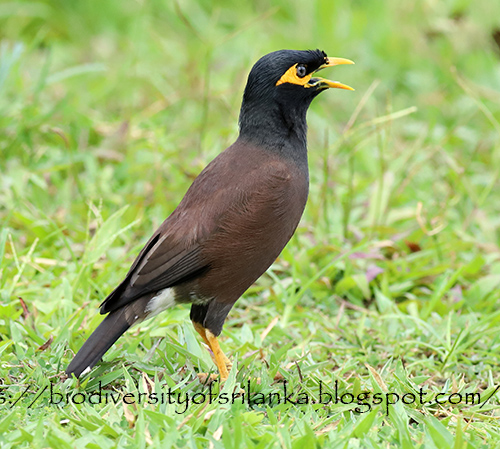English Post >>
Pages
- Home
- Flora of Sri Lanka
- Dragonflies & Damselflies of Sri Lanka
- Butterflies of Sri Lanka
- Freshwater Fishes of of Sri Lanka
- Amphibians of Sri Lanka
- Snakes of Sri Lanka
- Tetrapod Reptiles of Sri Lanka
- Mammals of Sri Lanka
- Resident Birds of Sri Lanka
- Migrant Birds of Sri Lanka
- Vagrant Birds of Sri Lanka
- Status Uncertain or Doubtful Birds of Sri Lanka
Tuesday, March 19, 2024
බ්රාහ්මණ මයිනා (Sturnia pagodarum)
English Post >>
Thursday, August 31, 2023
සැළලිහිණියා/පොදු සැළලිහිණියා (Gracula indica)
තෙත් කලාපයේ පහත රට ප්රදේශ වල සිට කඳුකරයේ මධ්යම උස් මට්ටම් දක්වා වනාන්තර අද්දර, හොඳින් ගහකොළ සහිත ප්රදේශ සහ වනාන්තර වලට ආසන්න ගෙවතු වල සුලභ දේශීය පක්ෂියෙකි. වියලි කලාපයේ උස් ගස් සහිත වනාන්තර වලද ස්ථානීය වශයෙන් ඇතැම්විට හමුවේ. ජෝඩු වශයෙන් හෝ කුඩා රංචු වශයෙන් තියුණු හඩක් නගමින් නිතර එකිනෙකා සමග සම්බන්ධතාවය පවත්වාගනිමින්, බොහෝවිට ගස් වල වියන් ස්ථරයේ සැරිසරමින් ප්රධාන වශයෙන් පළතුරු ආහාරයට ගනිමින් දිවි ගෙවයි. මැයි සිට අගෝස්තු දක්වා කාලයේ ගසක බෙනයක බිත්තර දෙකක් පමණ දමා අභිජනනය කරයි.
English Post >>Sunday, November 20, 2022
රෝස සැරිකාවා/රෝස මයිනා (Pastor roseus)
එතරම් සුලභ නොවන සංචාරක පක්ෂියෙක් වන රෝස මයිනා ප්රධාන වශයෙන් පහත රට වියලි කලාපයේ, විශේෂයෙන්ම වෙරළබඩ ප්රදේශ වල තෘණභූමි, වගා බිම්, ගෙවතු මෙන්ම වනාන්තර වලද බොහෝවිට විශාල රංචු වශයෙන් හමුවේ. ඝෝෂාකාරි පක්ෂියෙක් වන අතර වැඩි වශයෙන් පොළොව මත සැරිසරමින් කෘමීන්, පළතුරු, කුඩා ගෙඩි වර්ග, මල් පැණි, සහ ධාන්ය වර්ග ආහාරයට ගනී. ඇතැම් වසර වල විශාල රංචු වශයෙන් දැකගන්නට හැකි වුවත් තවත් ඇතැම් වර්ෂ වල මුළුමනින්ම නොමැති තරම් අල්ප පක්ෂීන් ප්රමාණයක් මෙරට තුලදී වාර්තා වේ. රෝස මයිනන් රාත්රී කාලයේ රංචු වශයෙන් තෝරාගත් ගසක් හෝ පඳුරක් මත ලැගුම් ගනී. නැගෙනහිර යුරෝපයේ සහ මැදපෙරදිග ප්රදේශ වල අභිජනනය කරන රෝස මයිනන් මුළු ගහණයම ශීත කාලයේදි ඉන්දියාවේ සහ ලංකාවේ ගත කරයි. මෙරටට පැමිණෙන බොහෝ රෝස මයිනන් නොමේරු පක්ෂීන්ගේ පිහාටු දරන බව නිරීක්ෂණය කර ඇත.
English Post >>
Monday, May 2, 2022
මයිනා/ගොන් කවඩියා (Acridotheres tristis)
මුහුදු මට්ටමේ සිට මීටර 1700 ක පමණ උසක් දක්වා සියලුම දේශගුණික කලාප වල සුලභ දේශීය පක්ෂියෙකි. ගෙවතු, වගා බිම් සහ තණ බිම් ආදියෙහි හමුවන මයිනා ඝන වනාන්තර තුල හමු නොවේ. නිතරම එළ සහ මී ගවයන් සමග දැකිය හැකි අතර ඔවුන්ගේ ශරීරයේ සිටින කිනිතුල්ලන් මෙන්ම ගවයන් ගමන් කිරීමේදි ඔවුන්ගේ පාද වලින් බාදා වී පලා යන කෘමින් , විශේෂයෙන් පලගැටියන් ගොදුරු කර ගනී. සිංහල භාෂාවෙන් ගොන් කවඩියා යන නම මෙම පක්ෂියා හැඳින්වීමට මේ නිසා ගැමියන් අතර භාවිතා වේ. මයිනන් එකම ජෝඩුව ජීවිත කාලය තුලම එකට වෙසෙන බව විශ්වාස කරයි. නමුත් ඇතැම් විට අභිජනන කාලයෙන් පිට මාස වලදී පක්ෂීන් සැලකියයුතු තරම් ප්රමාණයක් එකතු වී රංචු ලෙසින්ද හැසිරෙන ආකාරය දැකිය හැක. එසේම රාත්රි කාලයේදී දහස් ගණන් පක්ෂීන් තෝරාගත් එක් ස්ථානයක ලැගුම් ගන්නා ආකාරය නිරීක්ෂණය කල හැක. බොහෝවිට ගස් කිහිපයක් (ඇතැම්විට ජනාකීර්ණ නගර මධ්යක) හෝ වගුරු බිමක ඇති පඳුරු කිහිපයක් මේ සඳහා තෝරාගනී. මාර්තු සිට අගෝස්තු හෝ සැප්තැම්බර් දක්වා කාලයේ ගස් බෙනයක කෝටු කැබලි, පිදුරු සහ පිහාටු ආදිය එකතු කර තනන කූඩුවක බිත්තර තුනක් හෝ හතරක් දමා අභිජනනය කරයි.
English Post >>
Monday, November 21, 2016
Rosy Starling/රෝස සැරිකාවා/රෝස මයිනා[Rosa Sarikava/Rosa Myna] (Pastor roseus)
Monday, January 18, 2016
සැළලිහිණියා [Salalihiniya]/Sri Lanka Hill Myna [Ceylon Grackle/Ceylon Hill Myna] (Gracula ptilogenys)
Wednesday, November 5, 2014
Vagrant Starlings (Family: Sturnidae) recorded in Sri lanka
Confirmed vagrants
- 4 birds were observed by Moditha Kodikara Arachchi on 7th February 2015 at Irukalampiddi, Mannar. (http://www.ceylonbirdclub.org/the_ceylon_bird_club_news.php)








